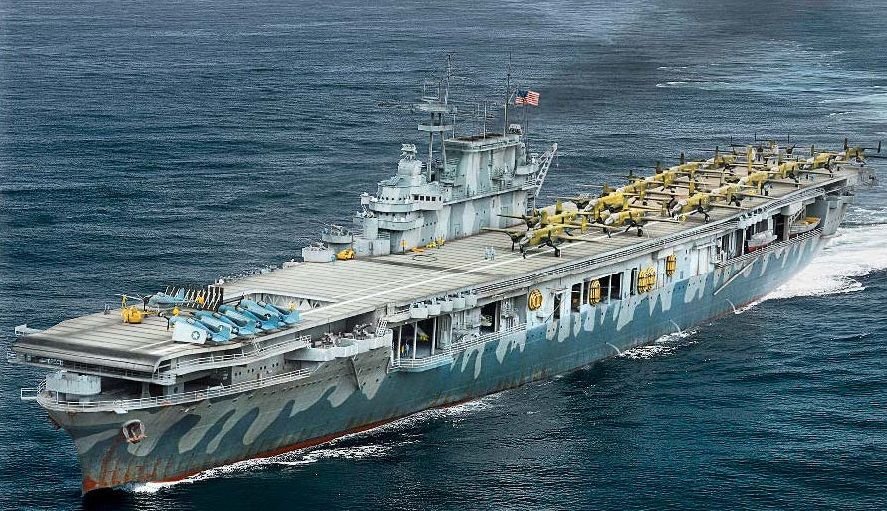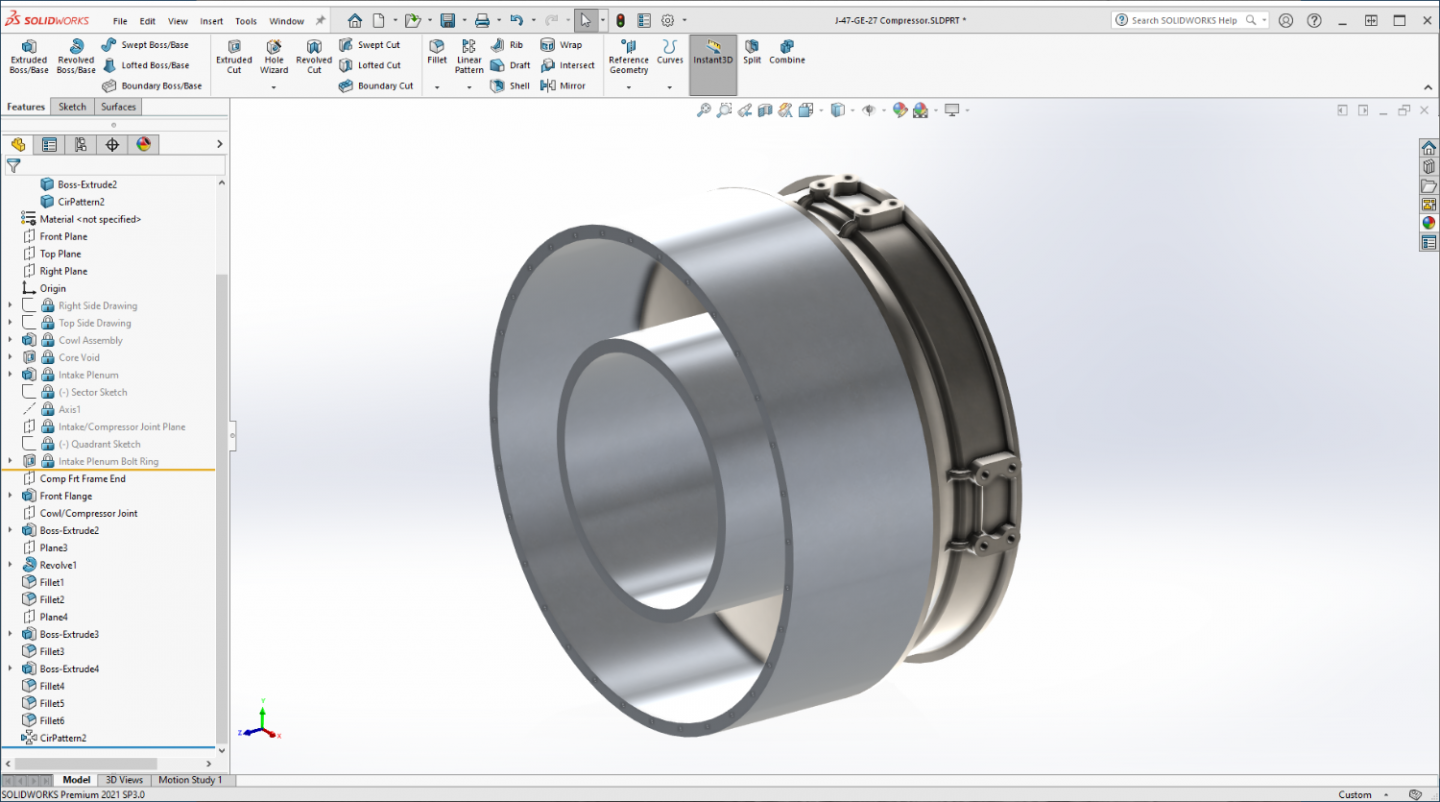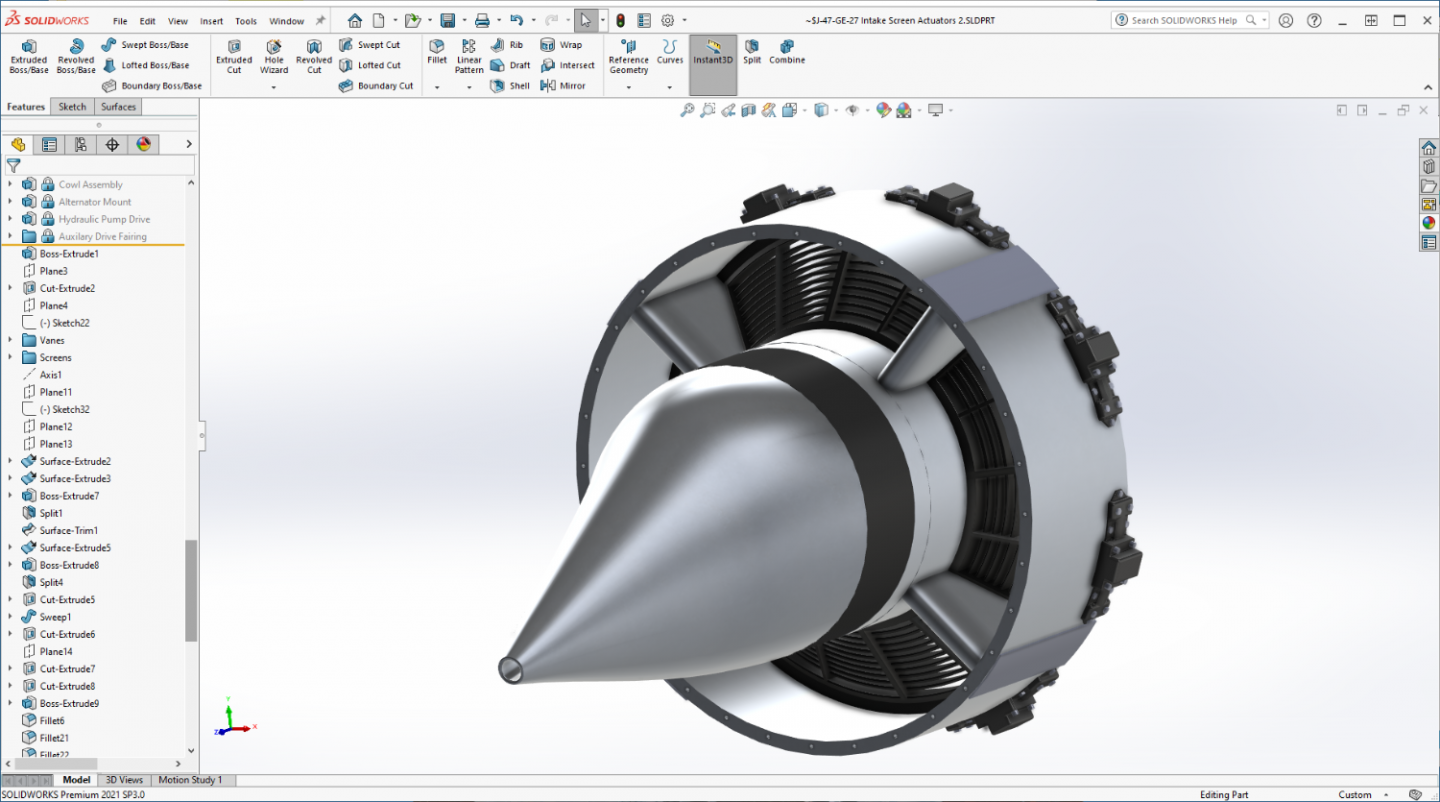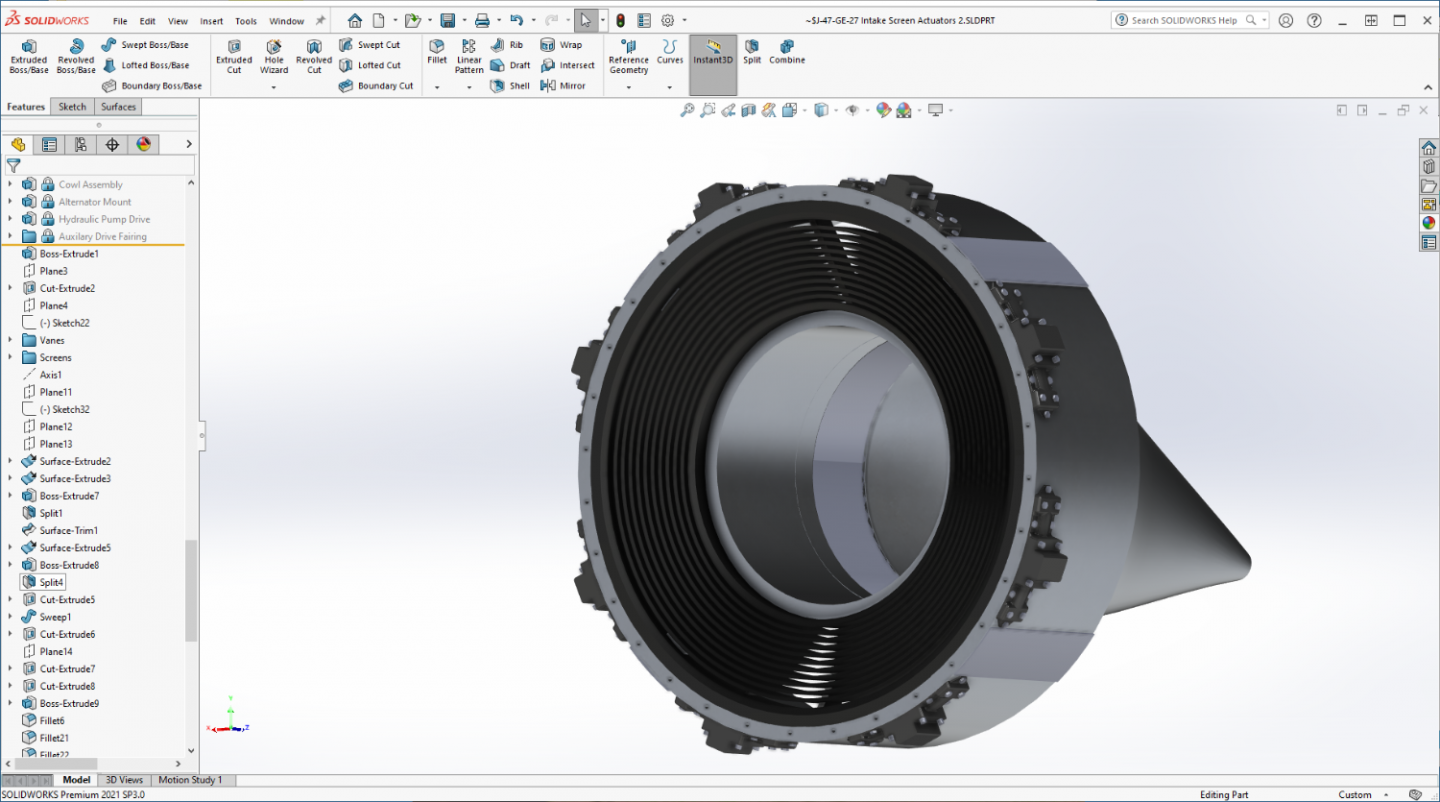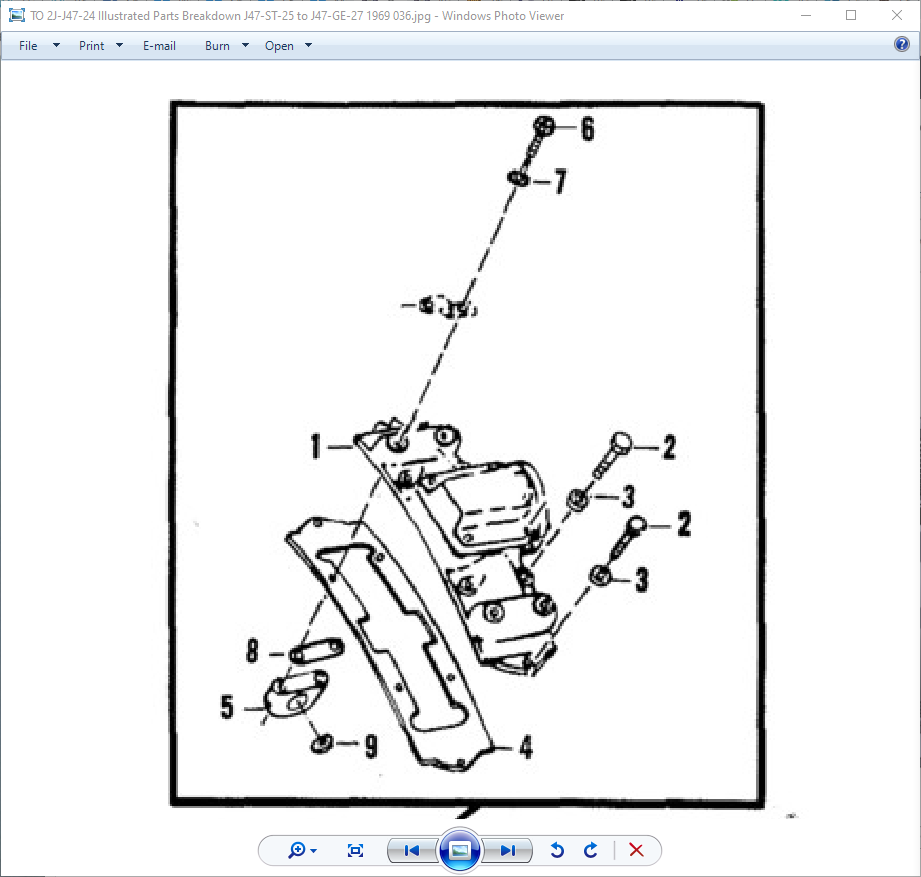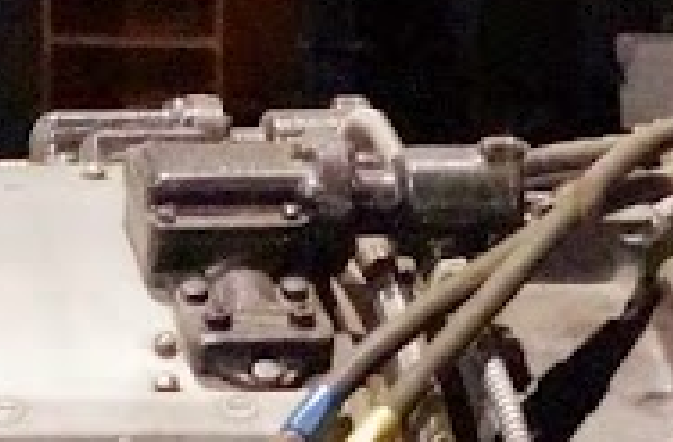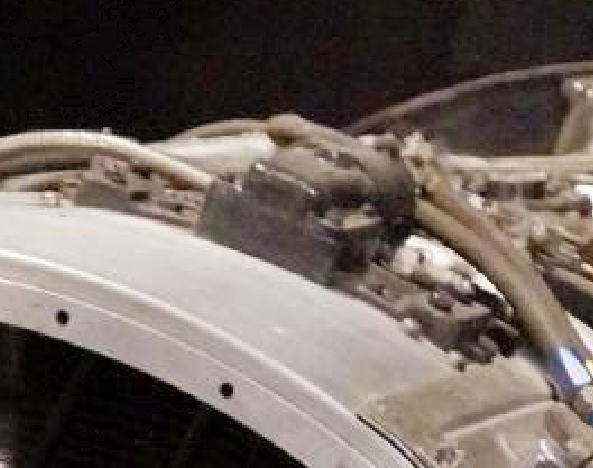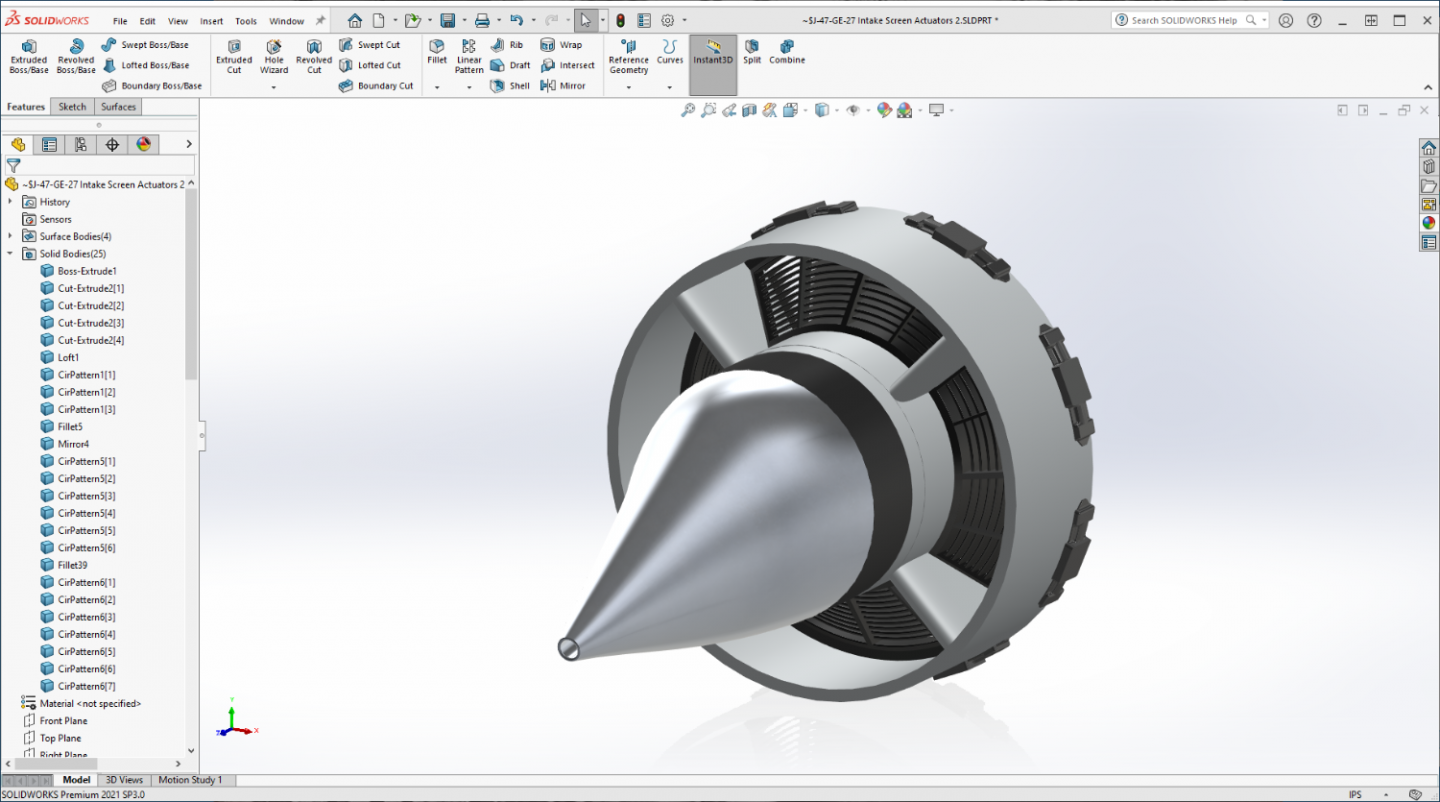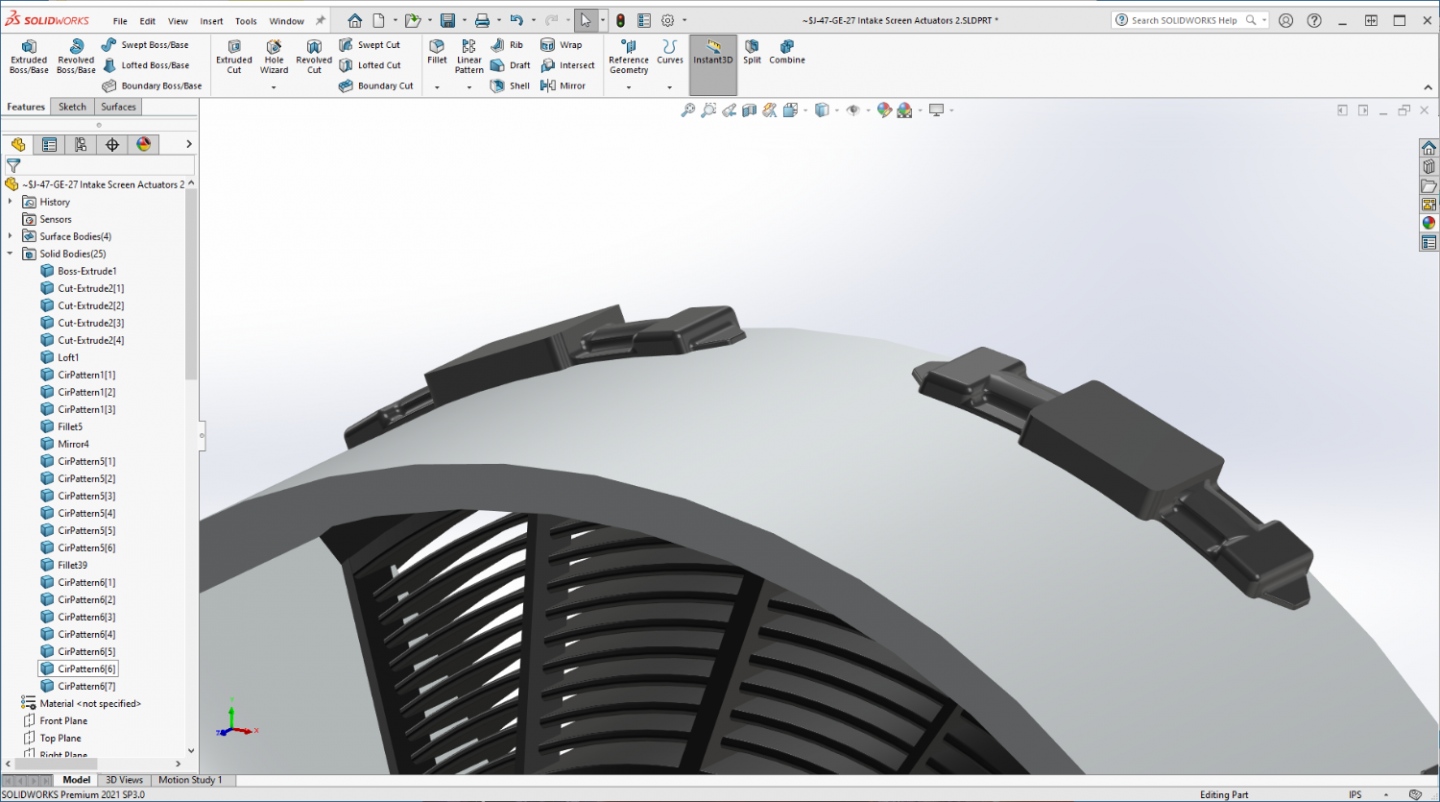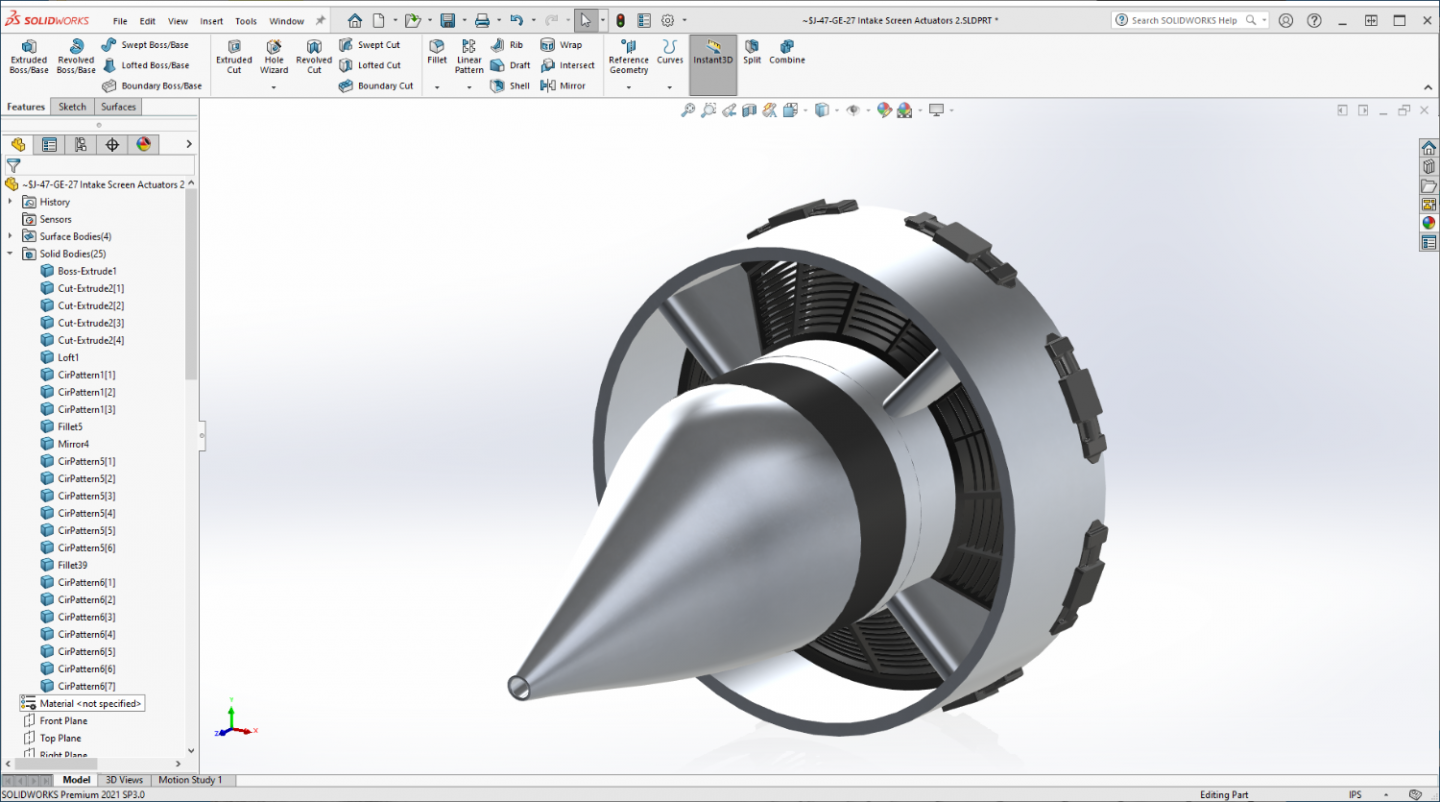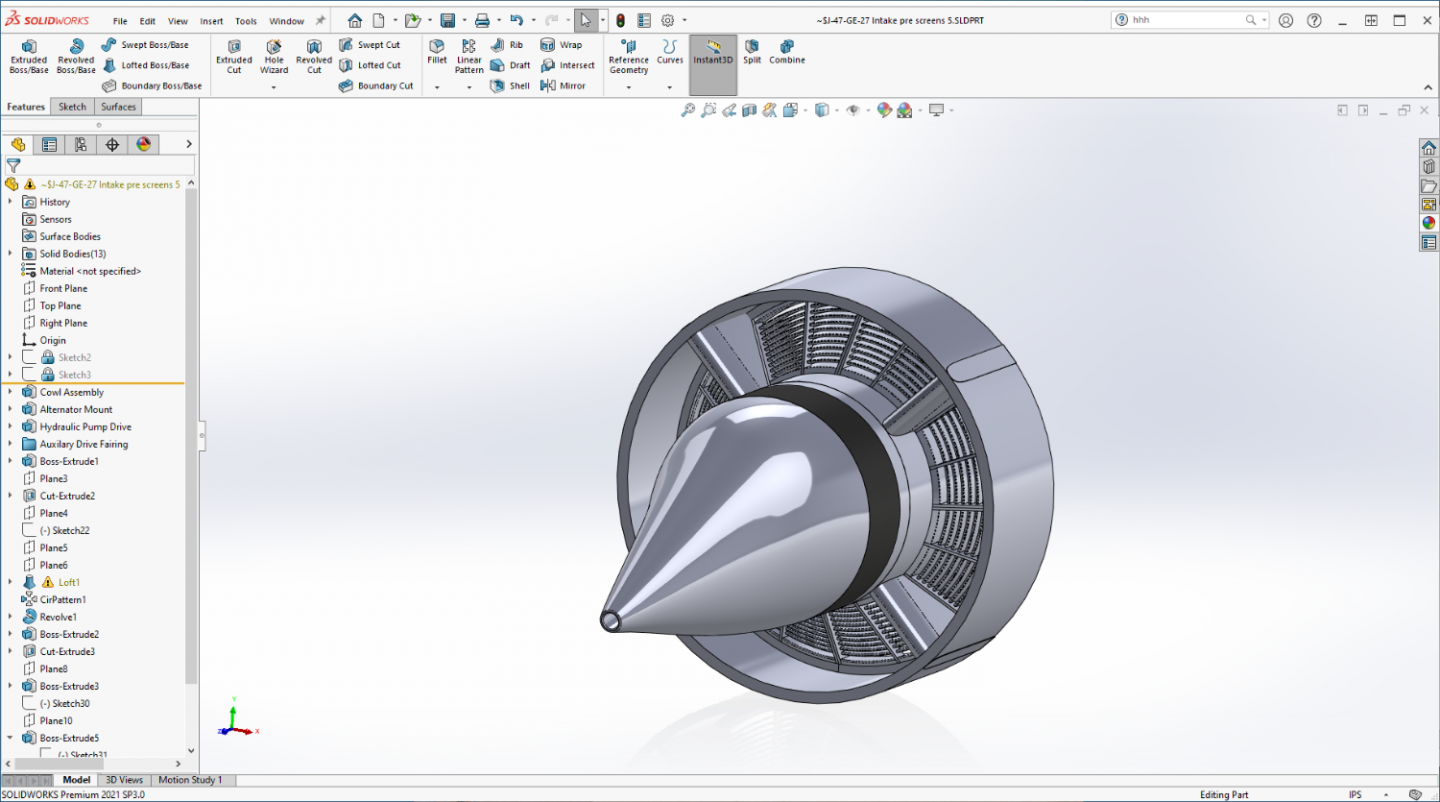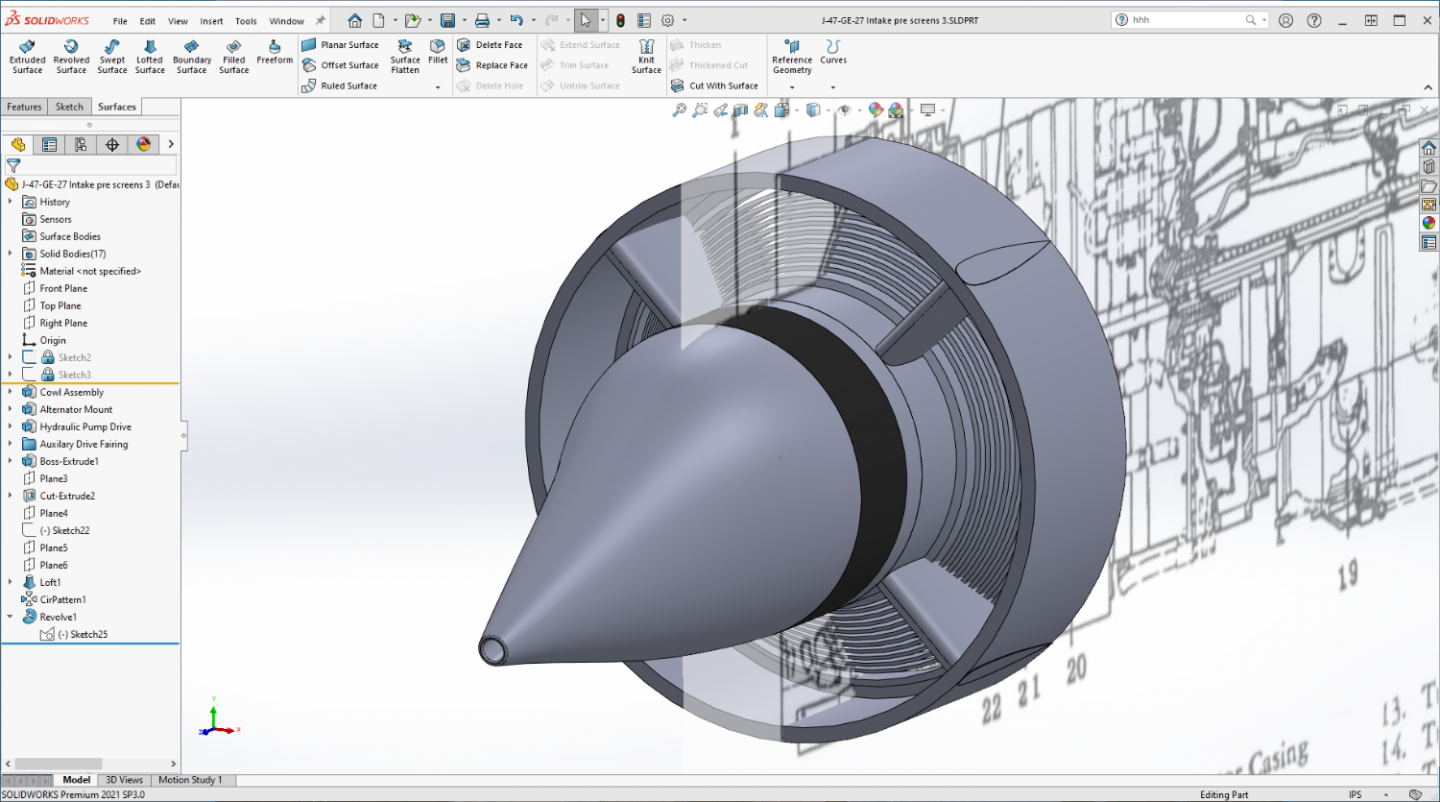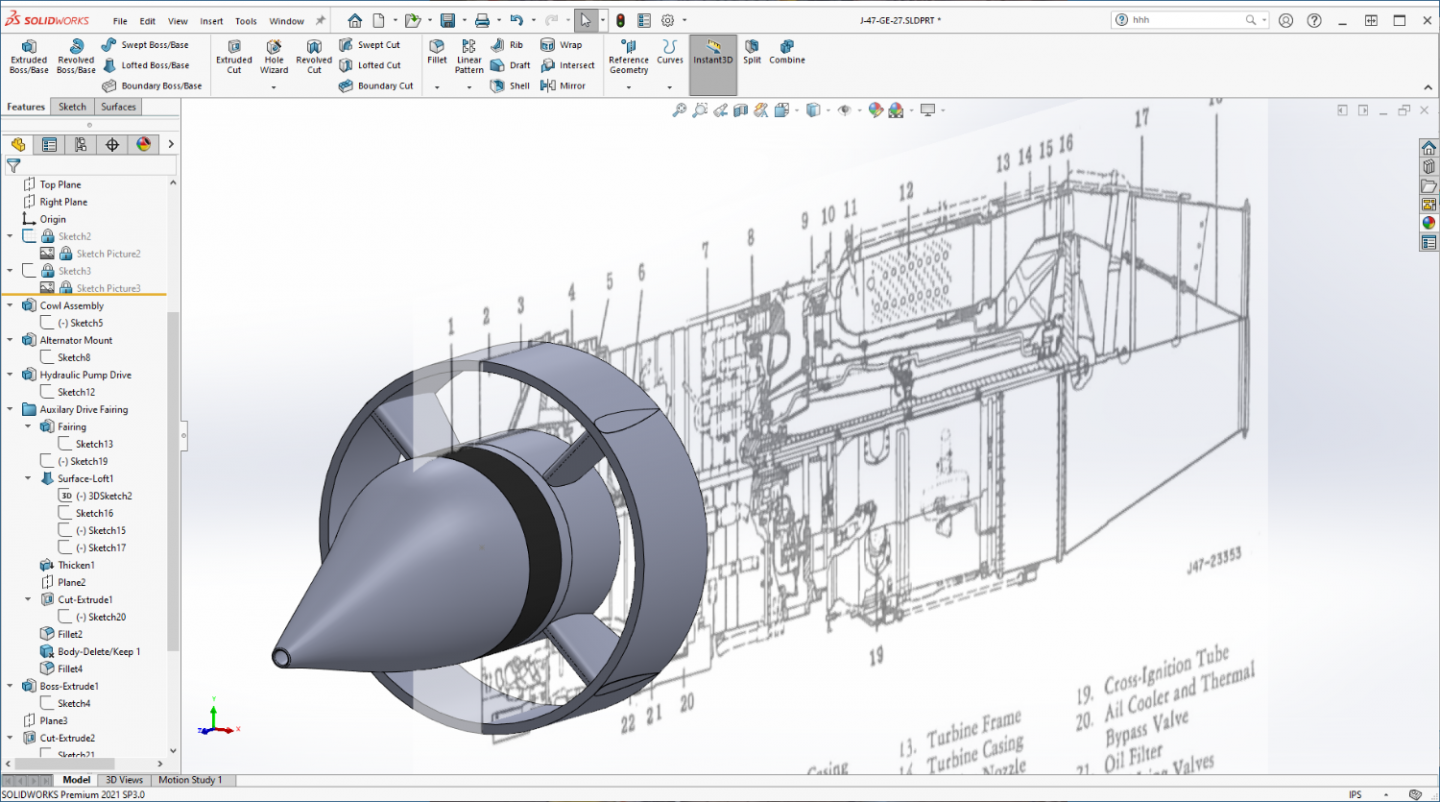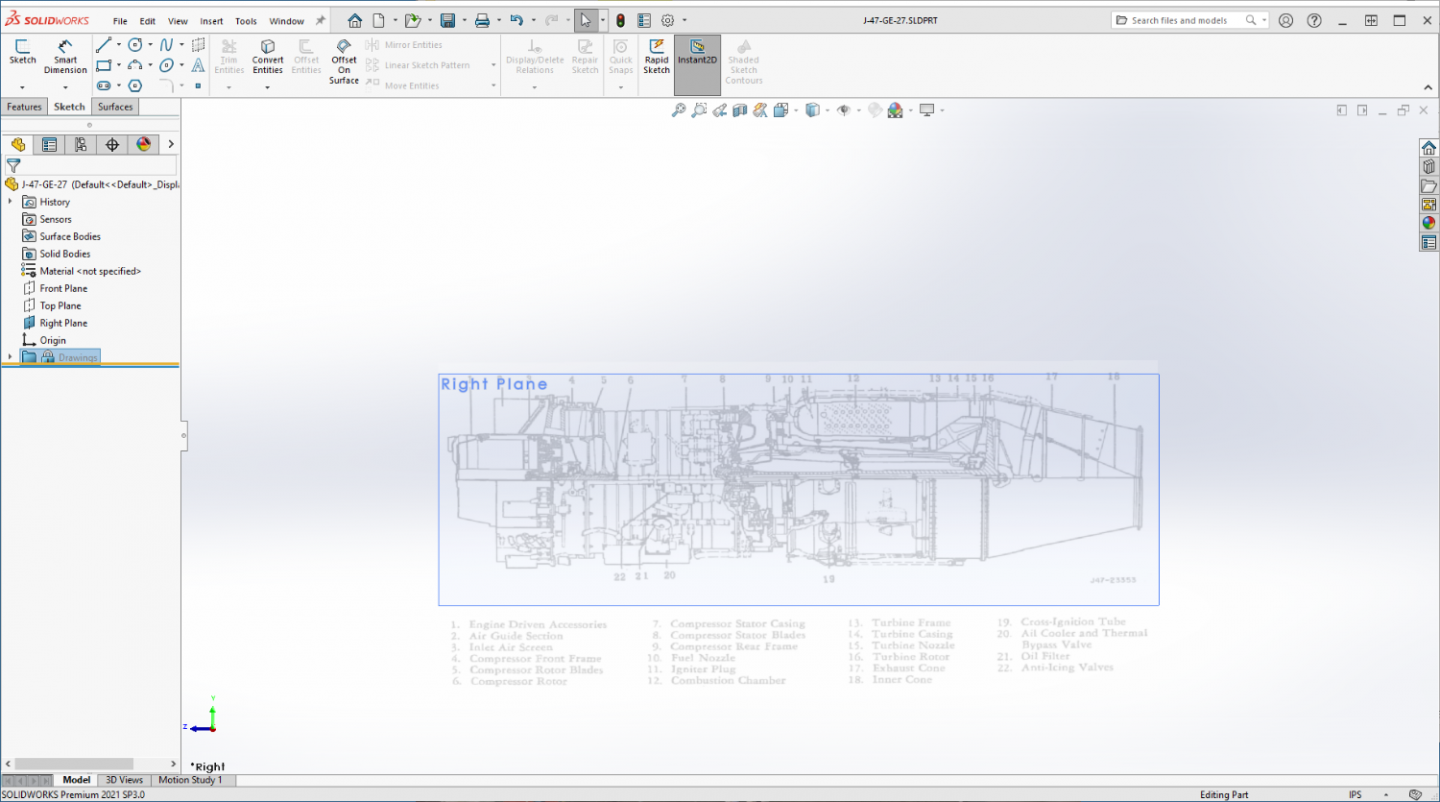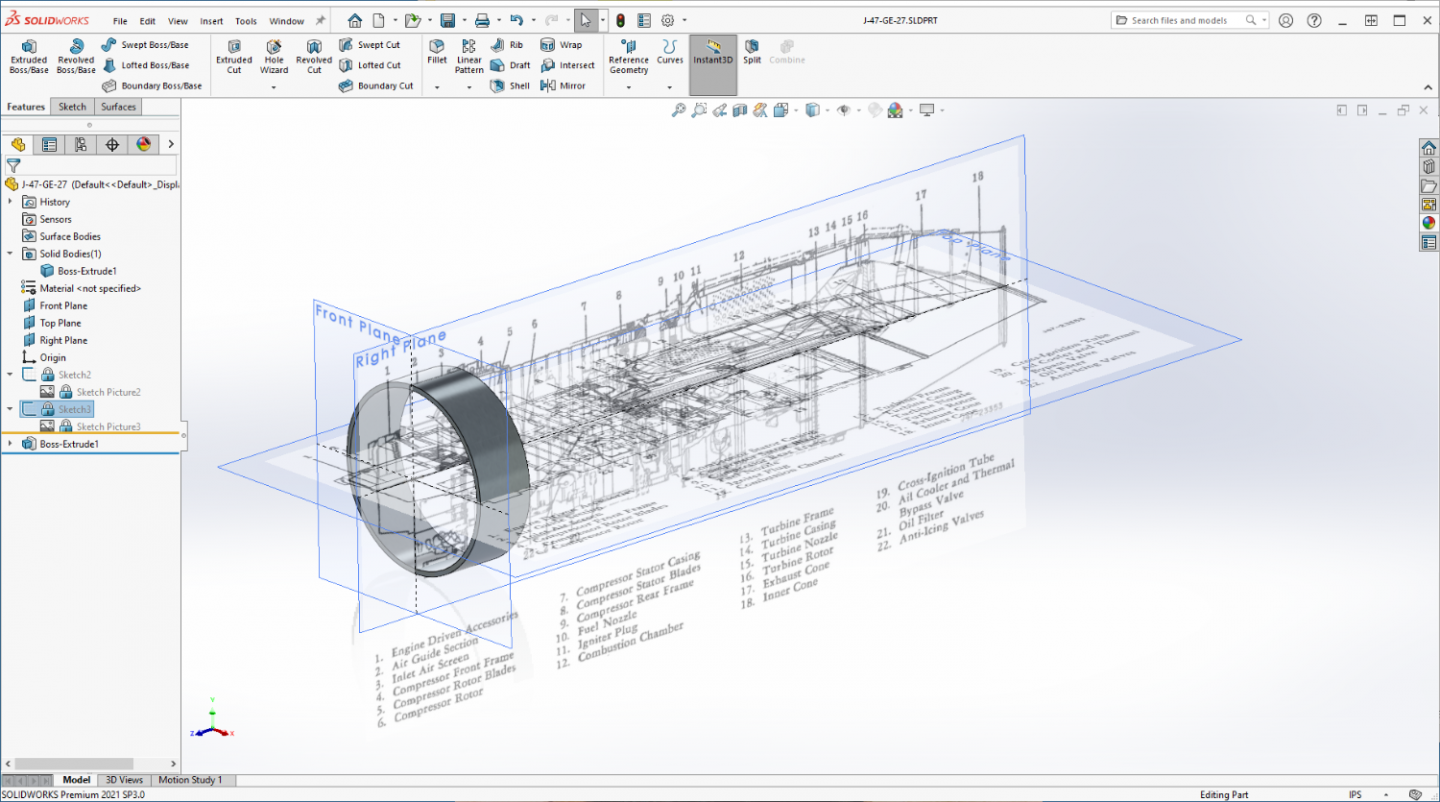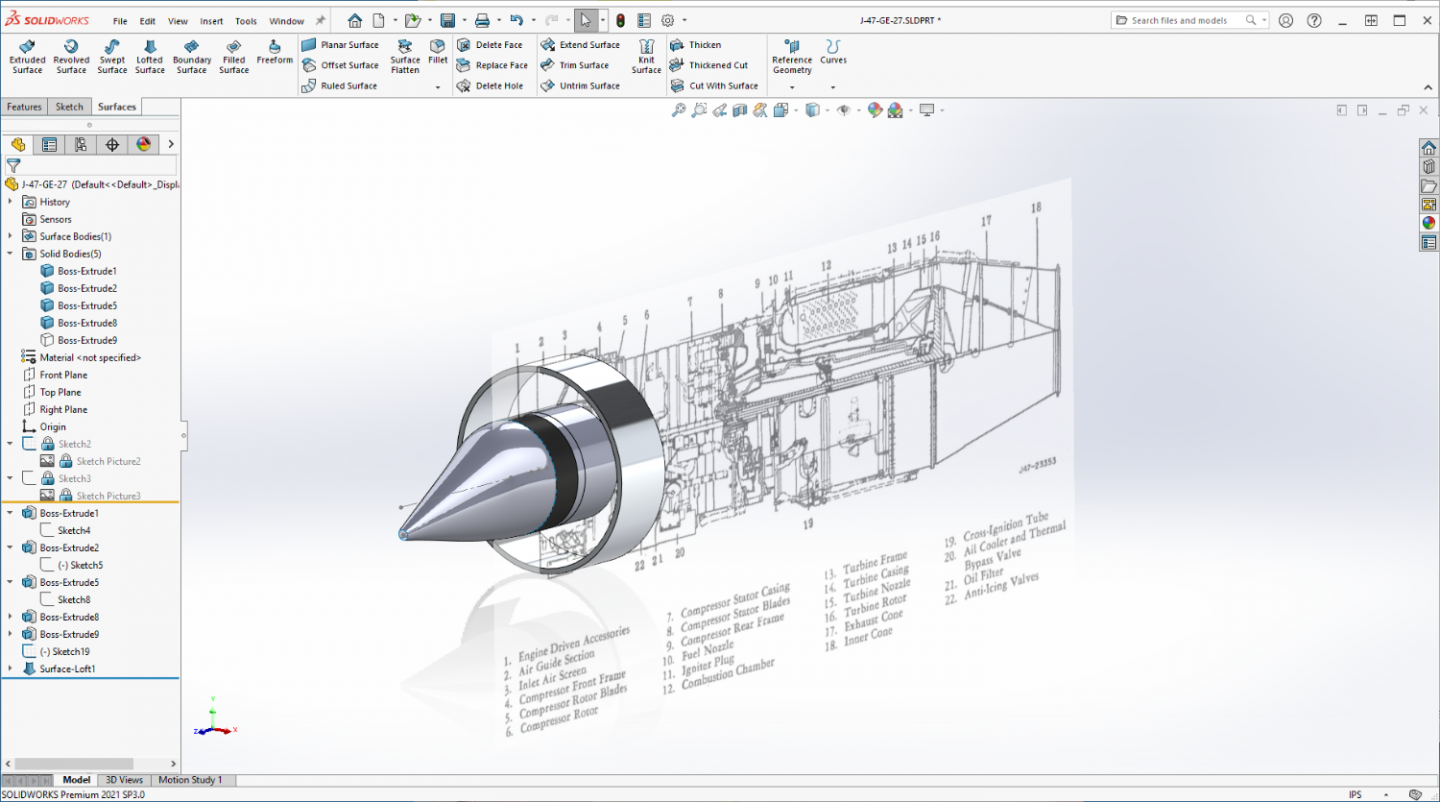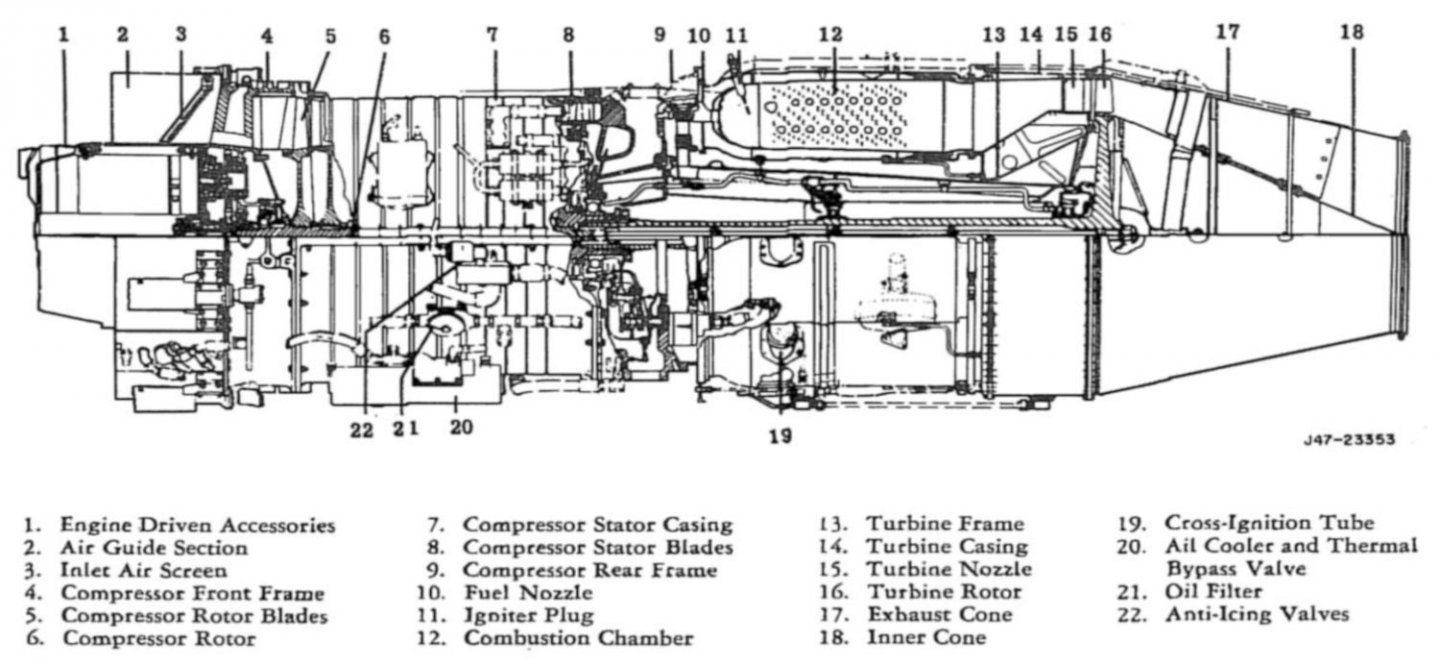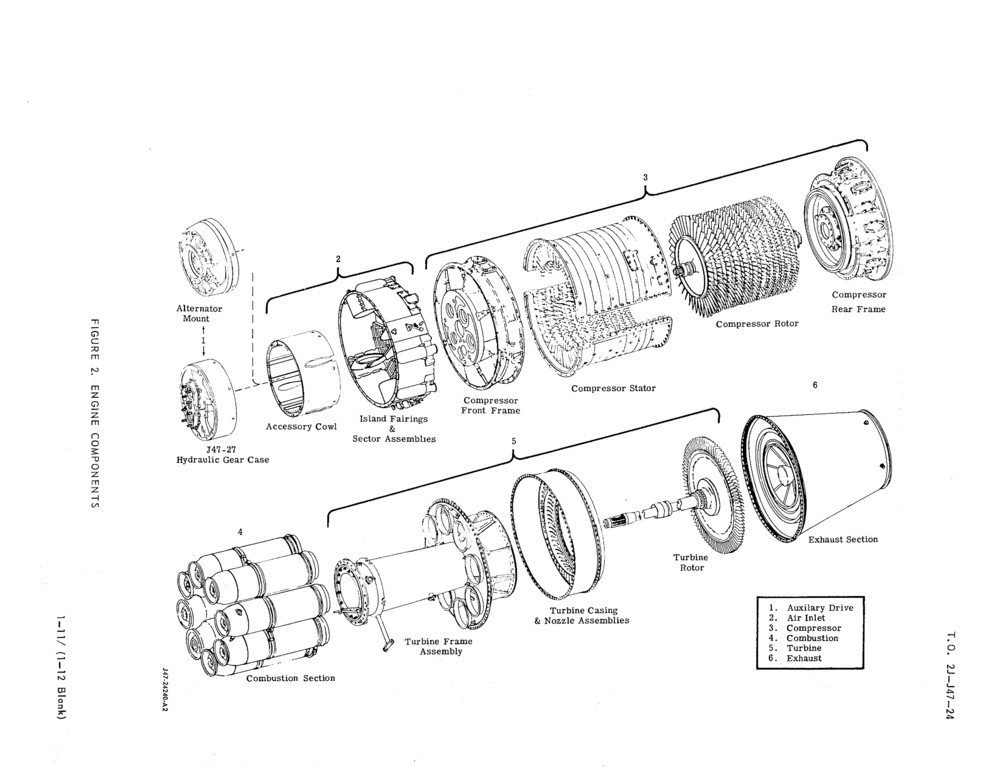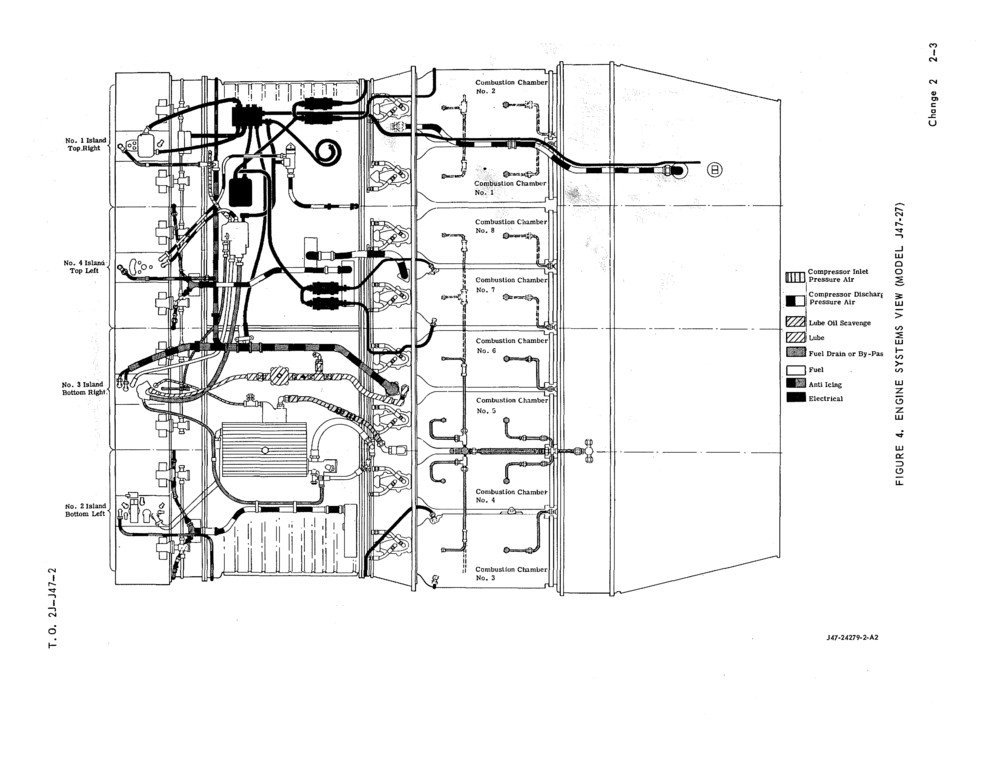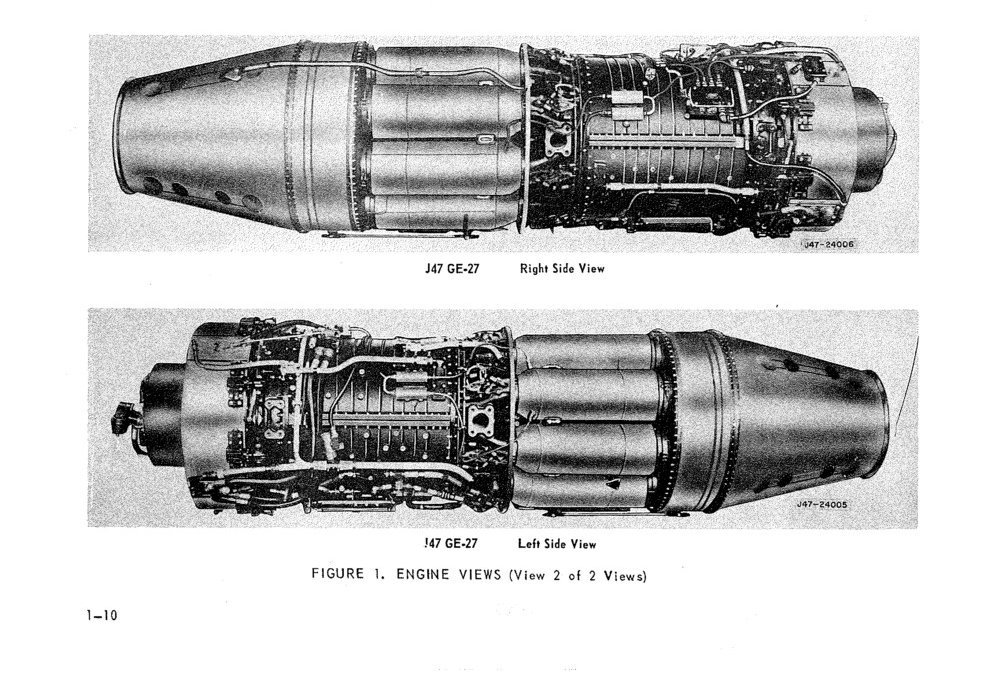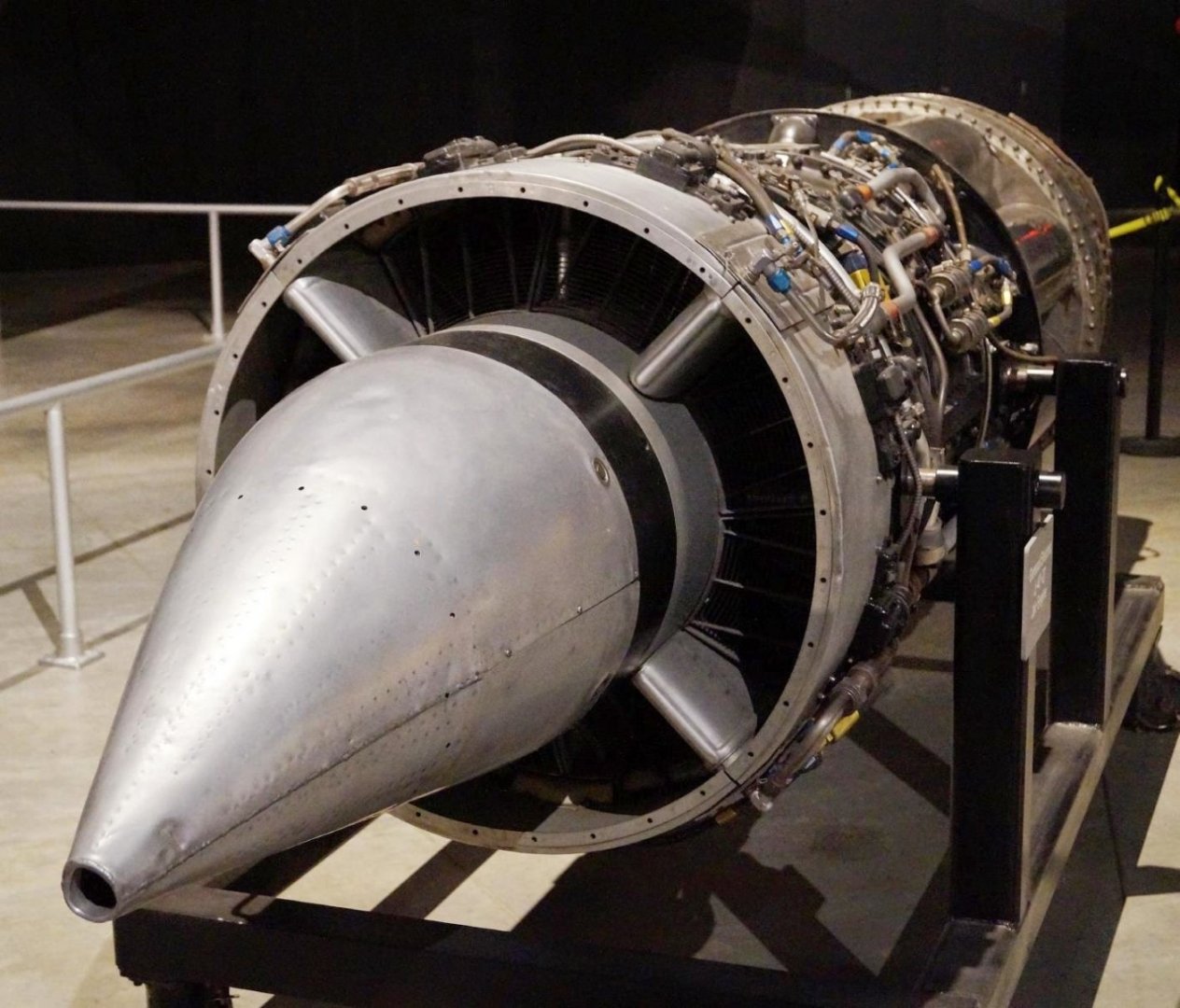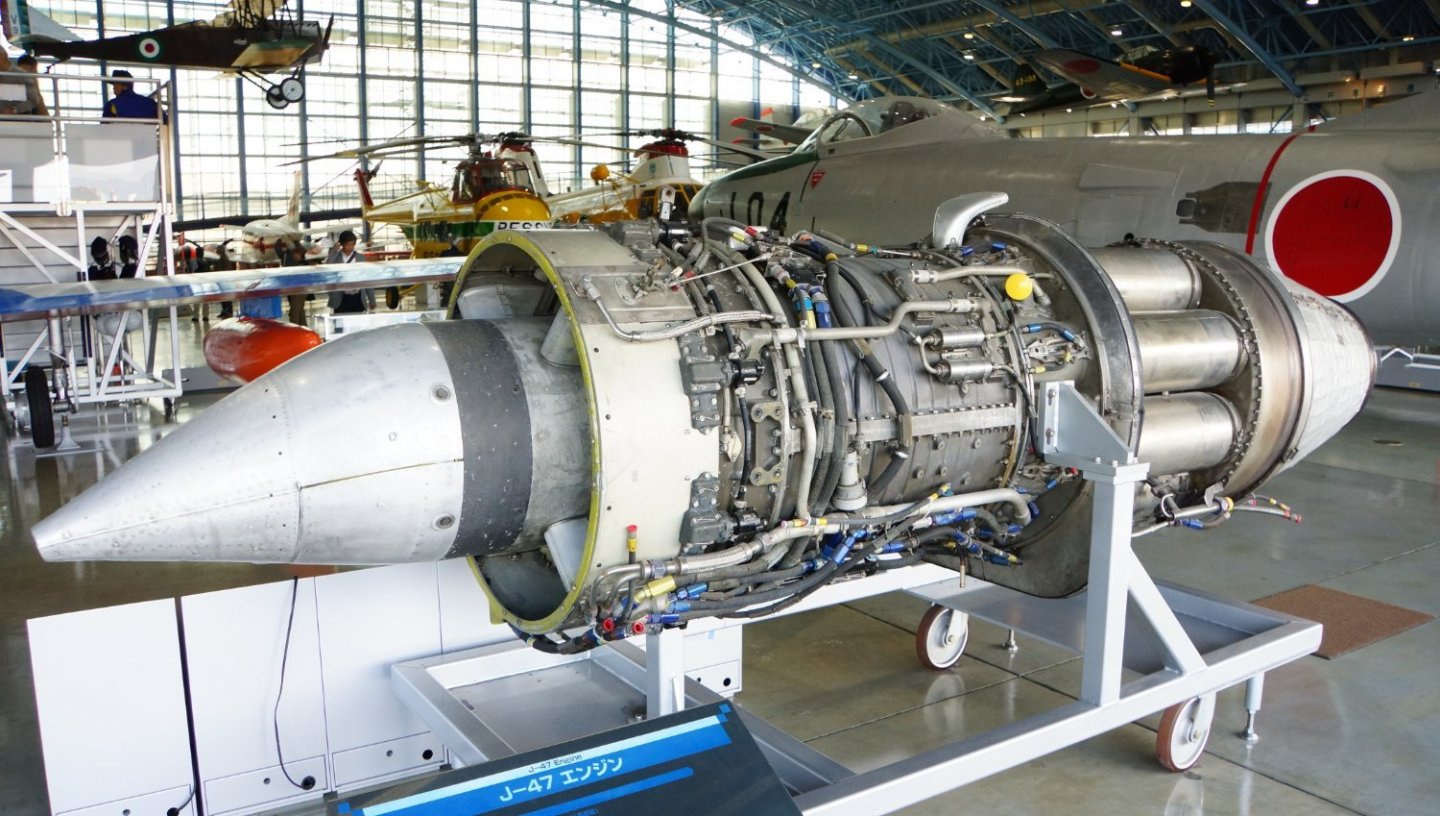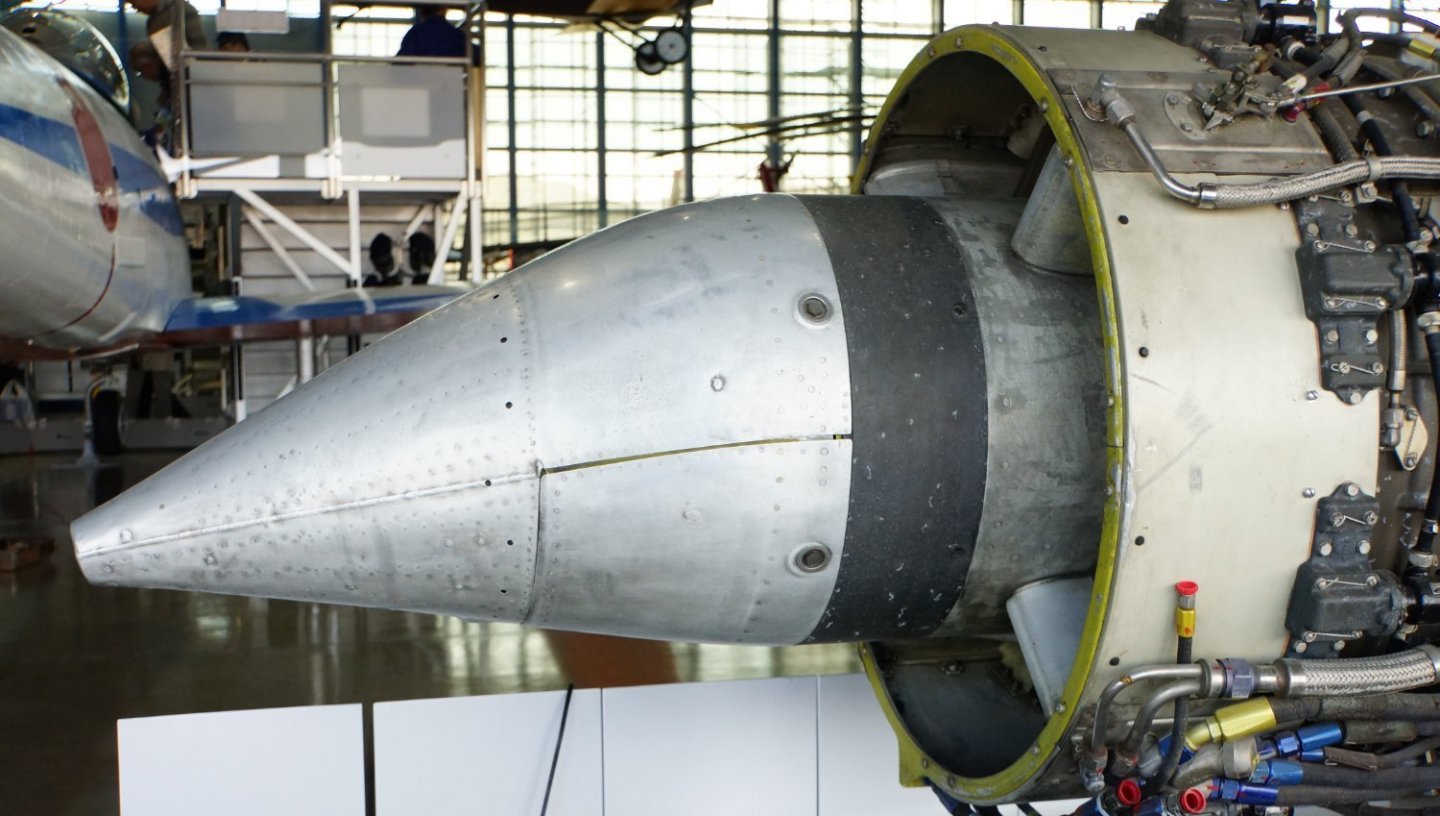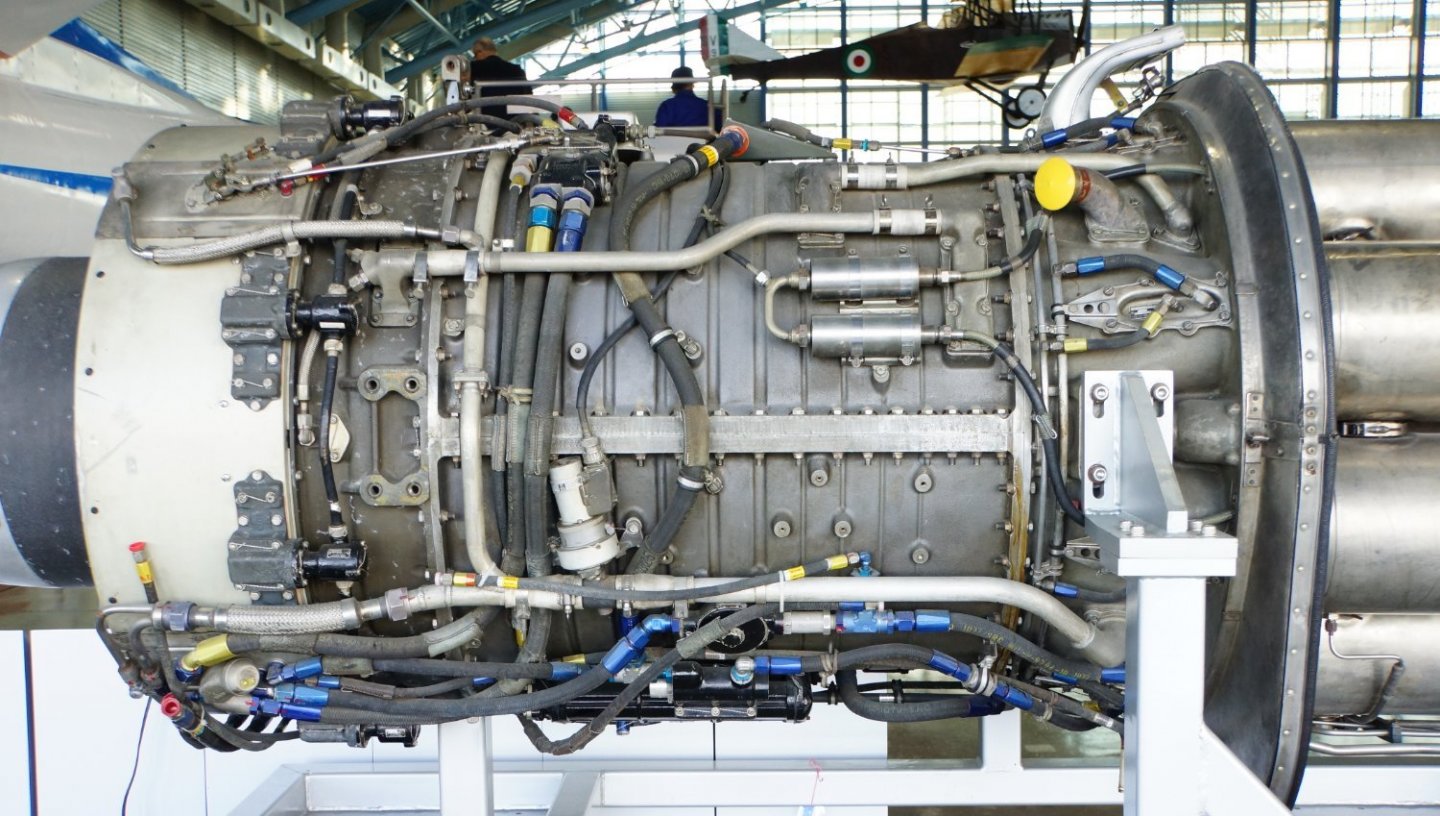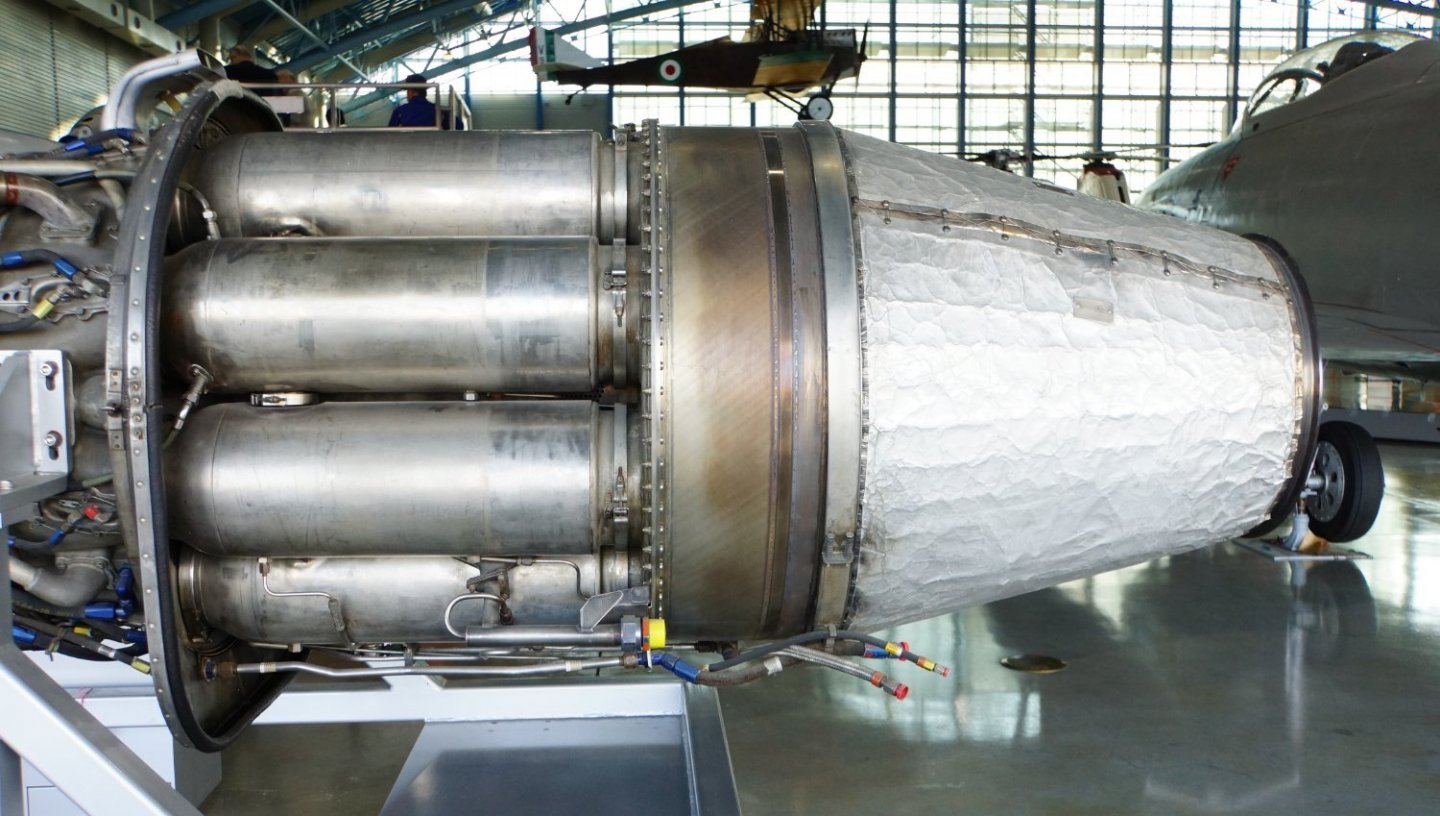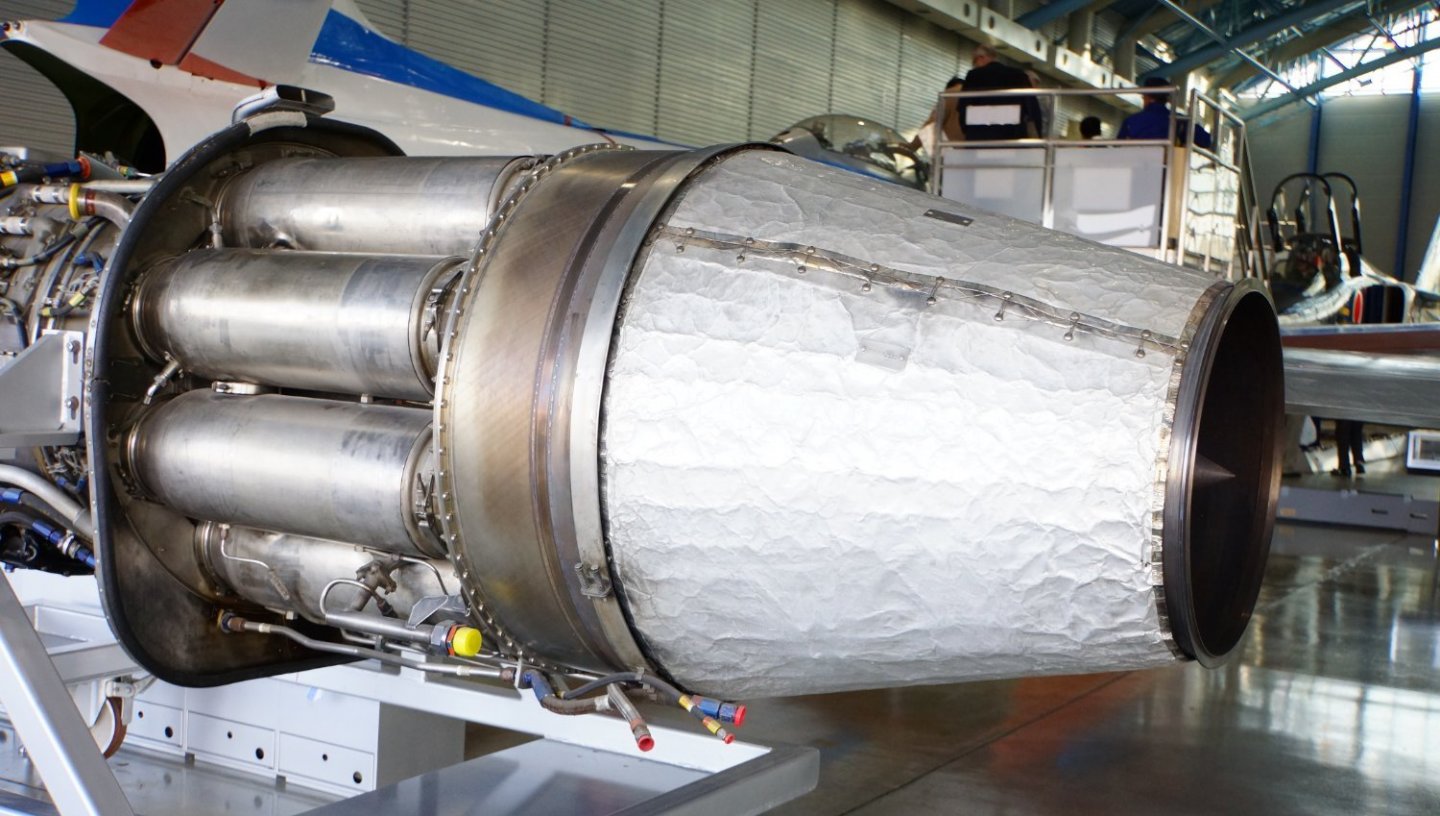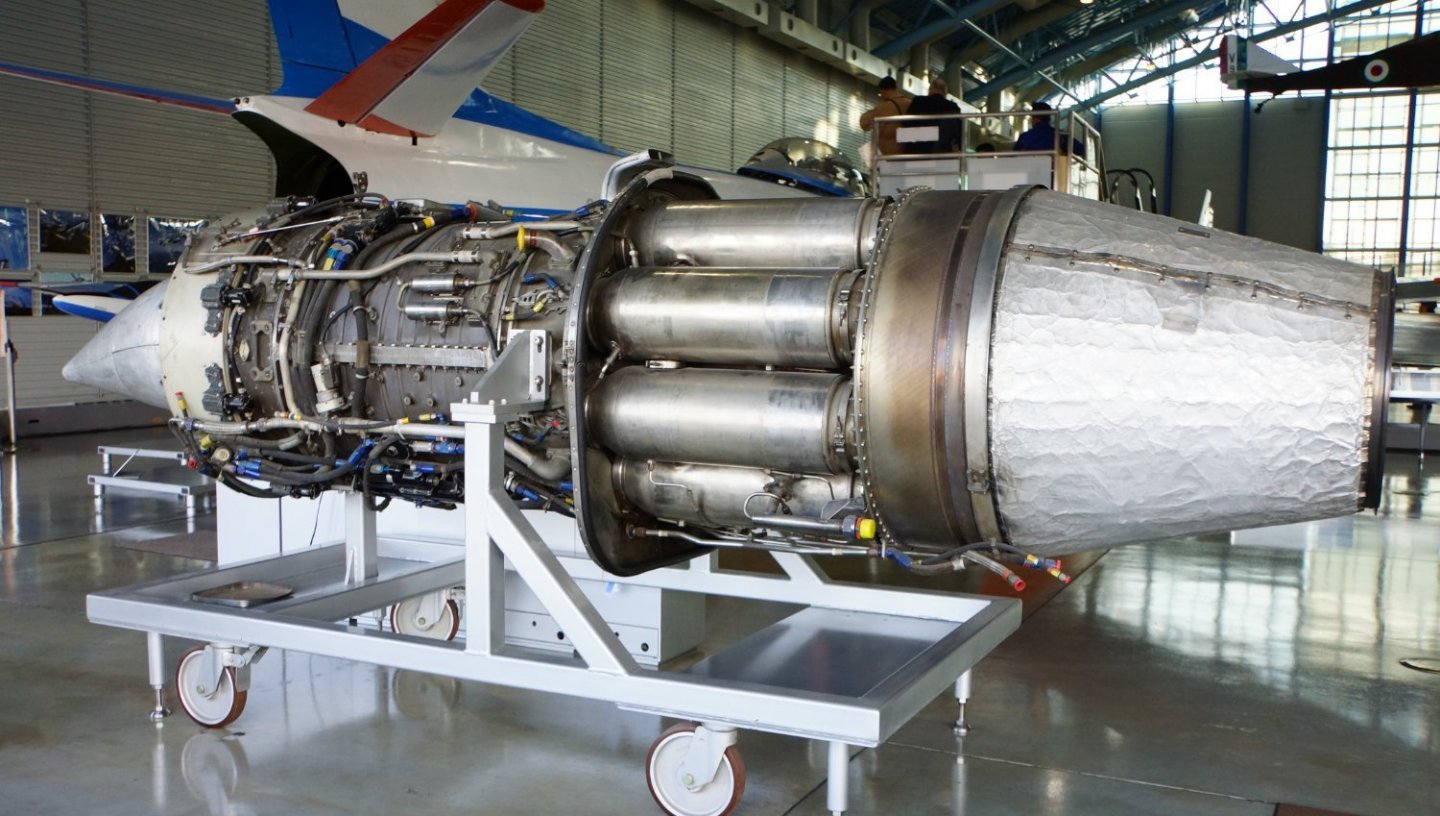-
Posts
4,373 -
Joined
-
Last visited
Content Type
Profiles
Forums
Gallery
Events
Everything posted by Egilman
-
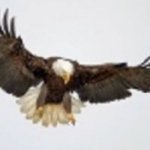
F-86F-30 Sabre by Javlin - FINISHED - Kinetic - 1/32
Egilman replied to Javlin's topic in Non-ship/categorised builds
That looks great my friend, I hope mine turns out half as well.... Very Nice... -

F-86F-30 Sabre by Egilman - Kinetic - 1/32nd scale
Egilman replied to Egilman's topic in Non-ship/categorised builds
Small update, Forward Compressor Frame... The basic casting with forward mounts is done, now need to add the details.... The bare Intake Plenum and Accessories housing were brought over from the previous Intake part to locate the relationship between the two... Onward.... Next up, (after adding the details to the frame, the Compressor housing halves and then the Aft Frame... Moving right along... -

F-86F-30 Sabre by Egilman - Kinetic - 1/32nd scale
Egilman replied to Egilman's topic in Non-ship/categorised builds
I think I'm done with the intake for now, this is where I stand.... The part of the actuators that make the screens move will get modeled at a later date along with the exterior details... It's at a good spot to go on with the basics... Back Side... I will also have to figure out a printing support and part assembly indexing situation for the back side yet, probably better to wait till I have a few parts drawn so I have a consistent system over the whole length of the engine... Anyways I'm calling this one done for now, on to the Compressor.... EG -

F-86F-30 Sabre by Egilman - Kinetic - 1/32nd scale
Egilman replied to Egilman's topic in Non-ship/categorised builds
Thanks Brother, the tech is amazing, even if it is 70 years old tech... Actually they made so many of these engines you can still find them in their shipping crates, Brand New... Thanks Gary, just trying to make something presentable that looks like the real thing... Still have some configuration and engineering to do to make it print successfully, but I'm learning as I go... I guess you can do all the step by step tutorials out there but you really don't learn it till you start making something of your own... And learning about each piece and what it did and why in the whole is engineering heaven... Moving on to the Compressor section shortly... It is kinda fun..... -
There is some awesome stuff out there... (if you can do it in plastic, there is someone doing it in paper)
-

F-86F-30 Sabre by Egilman - Kinetic - 1/32nd scale
Egilman replied to Egilman's topic in Non-ship/categorised builds
Another update my friends... This one was a bit of a solid modeling challenge.... The FOD Screen Hinge Actuator Mounts... From the parts manual, the base plate... Real Life... My rendition... Two tries and learning new ways of doing things.... ... and of course there are eight of them around outside of the intake plenum... Of course the caps still need to be modeled, and bolt heads, don't know how well they will print at 1/32 scale but I'm gonna give it a shot... Trying out a few finishes as well, I like the look of the fairing, not so much the other aluminum parts, probably going to switch it around a bit more... Anyway, that what I've been poking around with the last couple of days.... EG I think I like this better... Onwards! More Later... -
NOoooooo... CA is the worst glue for Styrene made... the best is liquid MEK... (Methyl Ethyl Ketone) Testors Plastic Cement for Models in liquid form...
-

F-86F-30 Sabre by Egilman - Kinetic - 1/32nd scale
Egilman replied to Egilman's topic in Non-ship/categorised builds
Another small update Brothers... A bit more tweaking to the FOD Screens... I think they look good, not exact, but I think good enough for what I'm doing... Yep a tad overscale, but it cant be helped... If I made them any thinner just touching them would cause them to break when scaled down... And I don't want that to happen... Any way this is where I'm at this morning... A few more details and then on to the compressor... EG -

F-86F-30 Sabre by Egilman - Kinetic - 1/32nd scale
Egilman replied to Egilman's topic in Non-ship/categorised builds
Thanks Ken... I'm finding that I didn't retain as much of SW as I thought I would, a perfect example of use it or lose it.... I imagine the same is true for Rhino as well... The FOD screens that are part of the J-47's intake plenum are automatic, they are closed below 500 ft altitude and open above that... Every engine I knew of had maintenance screens for ground operations.... (needed to be installed by hand) These were the first I ever saw that were integral to the engine and operated automatically... The trick here is to make them appear as they normally would closed, and not too much out of scale... Where I'm at now... (the vanes in the screens (real life) would be .015 or .020 thick, way too small to replicate in scale) A quarter inch in scale is only .008" The printer can handle 50 microns, (just under .002") the actual screen mesh would be .000625" in scale, a fine human hair is .003" so the ideal is to print in a buildable way something that looks real, what it really was doesn't matter... I'm on my second attempt at it now.... I imagine it will get easier as I gain practice and experience... but right now it's slow slogging... -

F-86F-30 Sabre by Egilman - Kinetic - 1/32nd scale
Egilman replied to Egilman's topic in Non-ship/categorised builds
No worries brother, between the autocorrect and my own flyin finners, I won't pass Sister Mary's english articulation class either... It happen to us all from time to time... -

F-86F-30 Sabre by Egilman - Kinetic - 1/32nd scale
Egilman replied to Egilman's topic in Non-ship/categorised builds
Thanks Alan, But, I don't understand the "I'm for screens" reference? If you don't mind me asking.... {chuckle} -

F-86F-30 Sabre by Egilman - Kinetic - 1/32nd scale
Egilman replied to Egilman's topic in Non-ship/categorised builds
Another small update brothers... The four vanes inside the intake.... It took four complete start-over type retries to get them to look right.... Next up is another difficult one, the retractable intake screens... They go in the four bays between the fins, a pair in each... They were for foreign object avoidance while on the ground and retracted into the intake plenum when they were airborne... They will be obvious when sitting on a dolly on the ground... It's coming along slowly... EG -

F-86F-30 Sabre by Egilman - Kinetic - 1/32nd scale
Egilman replied to Egilman's topic in Non-ship/categorised builds
All right an update.... Took the image I posted above into Gimp and cleaned it of a few irregularities... Then loaded it up in Solidworks and scaled it 1-1 for modeling... Started with the intake, that's where the most issues were and seemed like as good a place as any... After a little more plugging around, (had to take a quickie refresher on SW) I got to what is beginning to resemble an intake for a Turbine engine.... More later... EG -

Question About Glue for Plastic
Egilman replied to Gregory's topic in Modeling tools and Workshop Equipment
Depends upon the plastic Greg... If your talking styrene as used for modeling purposes, Tamiya thin or Testors liquid cement is the go to... Testors also makes a "tube glue" which is jellied liquid cement and has it's uses, but most generally use straight liquid... They don't work on silicone based plastics or UDMH plastics or resins from 3D printers, but will work on most others like Styrene's, Acetate's, and PVC's.... (according to Testor's claims, I only use them for styrene) Hope that helps.. -

F-86F-30 Sabre by Egilman - Kinetic - 1/32nd scale
Egilman replied to Egilman's topic in Non-ship/categorised builds
Thank you my friends, I think I'm gonna give it a shot, I might as well, I have nothing but time and the skills gained will be of great benefit in the future... Of course I'll document the steps as I go for those that want to follow along... First step was finding or creating a suitable accurate image of the J-47-GE-27 to use... and I found one, not in the J-47 manuals, but in the F-86F maintenance manual... (go figure)... Here it is... This will allow me to create the basic shapes as individual parts and sculpt them according to the parts drawings... (the accessories fairing is going to be interesting to sculpt) Now, to remember how to load an image in Solidworks.... Thank you brothers for your input it is appreciated... -

F-86F-30 Sabre by Egilman - Kinetic - 1/32nd scale
Egilman replied to Egilman's topic in Non-ship/categorised builds
Your right roger, I went ahead and researched USAAC & USAF fighter cockpit colors WWII to post Korea... prior to WWII cockpit colors were generally ZC Yellow in the USAAC with black panels, (but it was all over the map as far as manufacturers using whatever they wanted) As WWII progress this changed to a mix of ZCG & ZCY and by 1943 an official directive was issued making the official cockpit color scheme Interior green, (a very dark form of ZC Green) and Matt Black from the lower edges of the instrument panels up... But still with the numbers of aircraft they were building per month, the manufacturers used whatever formulation of paints they could get as long as it held to the scheme... Post war, the USAAF retired virtually all it's fighter aircraft not tagged P-51 and turned over many existing deployed aircraft to allied nations... Along about 1947, the USAAF decided to change it's cockpit scheme in it's now F-51 aircraft to everything the pilot could see in the cockpit being black, everything else would be interior green except for the seat pan which would also be green... Of course this was of serious import to North American Aviation who was producing all these F-51's, their derivatives, and the soon to be F-86... 1948 the change in cockpit color scheme became official for all USAF fighter planes, with one change, Flat Black overall.... So NAA went to producing the F-86 with completely flat black cockpits. the change was easy for them as what they were producing was 99% black anyway... This lasted until November '53 just after the war ended, when they changed the scheme to Black panels over Grey Structure.... The orders also clearly laid out what to do with existing aircraft... When an aircraft came in for IRAN, the scheme would be changed to the new one anything less and they would leave it alone... There were probably aircraft in different schemes, rare but true... It usually took several months for a new scheme to be devised and tested and reported on and approved so I suspect some Sabres were painted Black over Grey in the cockpit prior to the end of the war, but not many.... Given the closeness to the end of the war the orders were issued making the change, I suspect this to be absolutely true... So the statement that 99% of the Sabre's built pre November '53 had all black cockpits is as far as I'm concerned completely true... Kevin, in 1943, the RAF and the USAAC got together and unified the color schemes for exchange aircraft, the AAC decided on what they were going to do with input from the RAF with the RAF agreeing to accept the aircraft as produced to make the production and delivery of thousands of aircraft under wartime condition more efficient... The RAF was using black in the cockpit from the start of WWII and the reason the AAC went to it could very well have been the suggestion or requirements of the RAF, I've been unable to find the smoking gun on that one though it does appear that it was a mutual decision and when the RAF started taking delivery of F-86's they accepted the all black cockpit as well.... In essence it was to ease fighter aircraft production issues during the war was the reason and it wasn't a complete adoption of British practice, kinda a compromise... That's the story as I've been able to piece it together, not definitive at all in any manner, just my opinion based upon the research I've done over the last day and a half... (although there are still many peeps that will argue the hell out of it, the preponderance of evidence say it was so) I hope that answers all questions as best as can be done... {chuckle} (I love to do research into such esoteric subjects as well) EG -

F-86F-30 Sabre by Egilman - Kinetic - 1/32nd scale
Egilman replied to Egilman's topic in Non-ship/categorised builds
Yes Alan, it's a real disappointment I'm sad to say, not up to the quality of the rest of the kit unfortunately... The only parts that look useable are the compressor section and the exhaust section, the rest is going to need some serious re-working to come even close... I'm going over my options.. one of the things I do have is the complete T.O. 2J-J47-24 which is the complete illustrated parts breakdown updated to 1975 and Field Maintenance & Replacement, Turbojet Engines, covering the J-47-GE-23 to J-47-GE-27, essentially the USAF's Chilton's manual for the J-47 engine, T.O 2J-J47-26 updated to 1974 as references..... If I had an actual engine I could rebuild it using that info... For example... Component Exploded View.... Surface Accessory Systems Routing Wrap... (shows the routing of all exterior tubing & wiring and where they connect) I have complete details on every part, and how they are supposed to fit together... I'm mulling over in my head if I want to take this alternate path and use that 3D printer I have.... If I can draw up the basic parts in Solidworks, (don't know how long that will take) I should be able to print up a complete engine overnight, the parts won't be that big... I know it will look one heck of a lot more realistic than anything I do with bashing the kits plastic afterthought of an engine... So I'm asking for opinions, I'm pretty sure I can do it better, but I've never done this 3D work before in an actual model creation environment... I have all the materials and tools needed... Wanna take this detour along with me? (I pretty much figure the parts I have coming will all be here by the time I'm done) What do you think Brothers? -

F-86F-30 Sabre by Egilman - Kinetic - 1/32nd scale
Egilman replied to Egilman's topic in Non-ship/categorised builds
Ok, research update here.... GE J-47-27 Engine, as fitted to almost all F-86F's.... The kit engine.... Not glued together, just stacked to show what comes with the kit... The best thing I can say for it is that it resembles a J-47.... as you can easily see it is soft on detail and it's a bit out of scale on the larger side.... the real engine has a length of 145" (without tailpipe) and a diameter of 36.75" in scale that would be 4.53125" long (4&17/32nds inch) and 1.148" in diameter... So I'll have to work with what I got.. first off the real engine... (from TO 2J-J47-24 Illustrated Parts Breakdown J47-ST-25 to J47-GE-27 1969) And actual engine pics from a museum in Japan.... And finally the intake end... where the major issues are... Just several things noticeable... 1. The intake casing is too narrow should be about double it's length... 2. The intake has four flow vanes for the anti icing system which are completely missing... 3. The accessory drive cover is too short and starts angling downward almost immediately, it should protrude from the intake casing twice the true width of the casing before it starts angling downward... 4. The accessory drive cover has a flat nose with hole for cooling air flow to access the accessories.... 5. The eight burner cans do not taper and are woefully underscale... 6. The tailpipe is not part of the engine... It looks like I can save most of the compressor, at least I can work with it... (probably add some details as well... Now, working out how to go about fixing it.... Onwards Brothers... -

Martini Porsche 935 by kpnuts - FINISHED - Tamiya - 1/12
Egilman replied to kpnuts's topic in Non-ship/categorised builds
Ahhhh, the master is at work again.... You still amaze me with your skills at replicating real life....
About us
Modelshipworld - Advancing Ship Modeling through Research
SSL Secured
Your security is important for us so this Website is SSL-Secured
NRG Mailing Address
Nautical Research Guild
237 South Lincoln Street
Westmont IL, 60559-1917
Model Ship World ® and the MSW logo are Registered Trademarks, and belong to the Nautical Research Guild (United States Patent and Trademark Office: No. 6,929,264 & No. 6,929,274, registered Dec. 20, 2022)
Helpful Links
About the NRG
If you enjoy building ship models that are historically accurate as well as beautiful, then The Nautical Research Guild (NRG) is just right for you.
The Guild is a non-profit educational organization whose mission is to “Advance Ship Modeling Through Research”. We provide support to our members in their efforts to raise the quality of their model ships.
The Nautical Research Guild has published our world-renowned quarterly magazine, The Nautical Research Journal, since 1955. The pages of the Journal are full of articles by accomplished ship modelers who show you how they create those exquisite details on their models, and by maritime historians who show you the correct details to build. The Journal is available in both print and digital editions. Go to the NRG web site (www.thenrg.org) to download a complimentary digital copy of the Journal. The NRG also publishes plan sets, books and compilations of back issues of the Journal and the former Ships in Scale and Model Ship Builder magazines.

